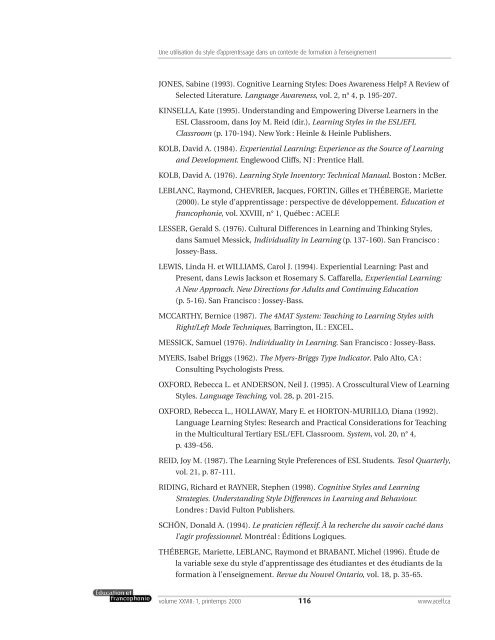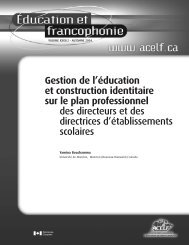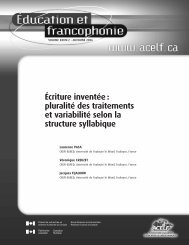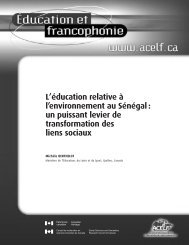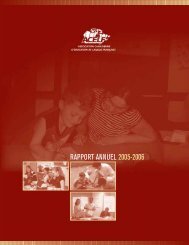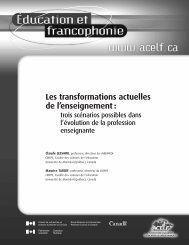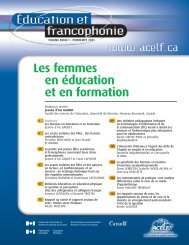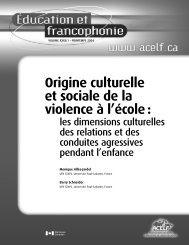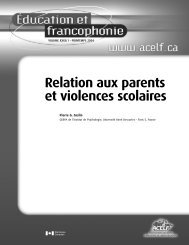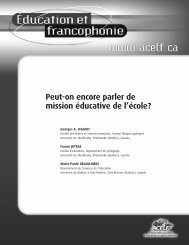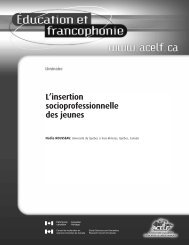Create successful ePaper yourself
Turn your PDF publications into a flip-book with our unique Google optimized e-Paper software.
Une utilisation du <strong>style</strong> d’apprentissage dans un contexte de formation à l’enseignementJONES, Sabine (1993). Cognitive <strong>Le</strong>arning Styles: Does Awareness Help? A Review ofSelected Literature. Language Awareness, vol. 2, n° 4, p. 195-207.KINSELLA, Kate (1995). Understanding and Empowering Diverse <strong>Le</strong>arners in theESL Classroom, dans Joy M. Reid (dir.), <strong>Le</strong>arning Styles in the ESL/EFLClassroom (p. 170-194). New York : Heinle & Heinle Publishers.KOLB, David A. (1984). Experiential <strong>Le</strong>arning: Experience as the Source of <strong>Le</strong>arningand Development. Englewood Cliffs, NJ : Prentice Hall.KOLB, David A. (1976). <strong>Le</strong>arning Style Inventory: Technical Manual. Boston : McBer.LEBLANC, Raymond, CHEVRIER, Jacques, FORTIN, Gilles et THÉBERGE, Mariette(2000). <strong>Le</strong> <strong>style</strong> d’apprentissage : perspective de développement. Éducation etfrancophonie, vol. XXVIII, n° 1, Québec : ACELF.LESSER, Gerald S. (1976). Cultural Differences in <strong>Le</strong>arning and Thinking Styles,dans Samuel Messick, Individuality in <strong>Le</strong>arning (p. 137-160). San Francisco :Jossey-Bass.LEWIS, Linda H. et WILLIAMS, Carol J. (1994). Experiential <strong>Le</strong>arning: Past andPresent, dans <strong>Le</strong>wis Jackson et Rosemary S. Caffarella, Experiential <strong>Le</strong>arning:A New Approach. New Directions for Adults and Continuing Education(p. 5-16). San Francisco : Jossey-Bass.MCCARTHY, Bernice (1987). The 4MAT System: Teaching to <strong>Le</strong>arning Styles withRight/<strong>Le</strong>ft Mode Techniques, Barrington, IL : EXCEL.MESSICK, Samuel (1976). Individuality in <strong>Le</strong>arning. San Francisco : Jossey-Bass.MYERS, Isabel Briggs (1962). The Myers-Briggs Type Indicator. Palo Alto, CA :Consulting Psychologists Press.OXFORD, Rebecca L. et ANDERSON, Neil J. (1995). A Crosscultural View of <strong>Le</strong>arningStyles. Language Teaching, vol. 28, p. 201-215.OXFORD, Rebecca L., HOLLAWAY, Mary E. et HORTON-MURILLO, Diana (1992).Language <strong>Le</strong>arning Styles: Research and Practical Considerations for Teachingin the Multicultural Tertiary ESL/EFL Classroom. System, vol. 20, n° 4,p. 439-456.REID, Joy M. (1987). The <strong>Le</strong>arning Style Preferences of ESL Students. Tesol Quarterly,vol. 21, p. 87-111.RIDING, Richard et RAYNER, Stephen (1998). Cognitive Styles and <strong>Le</strong>arningStrategies. Understanding Style Differences in <strong>Le</strong>arning and Behaviour.Londres : David Fulton Publishers.SCHÖN, Donald A. (1994). <strong>Le</strong> praticien réflexif. À la recherche du savoir caché dansl’agir professionnel. Montréal : Éditions Logiques.THÉBERGE, Mariette, LEBLANC, Raymond et BRABANT, Michel (1996). Étude dela variable sexe du <strong>style</strong> d’apprentissage des étudiantes et des étudiants de laformation à l’enseignement. Revue du Nouvel Ontario, vol. 18, p. 35-65.volume XXVIII : 1, printemps 2000116www.<strong>acelf</strong>.ca


